LOTUS ELISE 2005 Workshop Manual
Manufacturer: LOTUS, Model Year: 2005, Model line: ELISE, Model: LOTUS ELISE 2005Pages: 205, PDF Size: 4.51 MB
Page 51 of 205
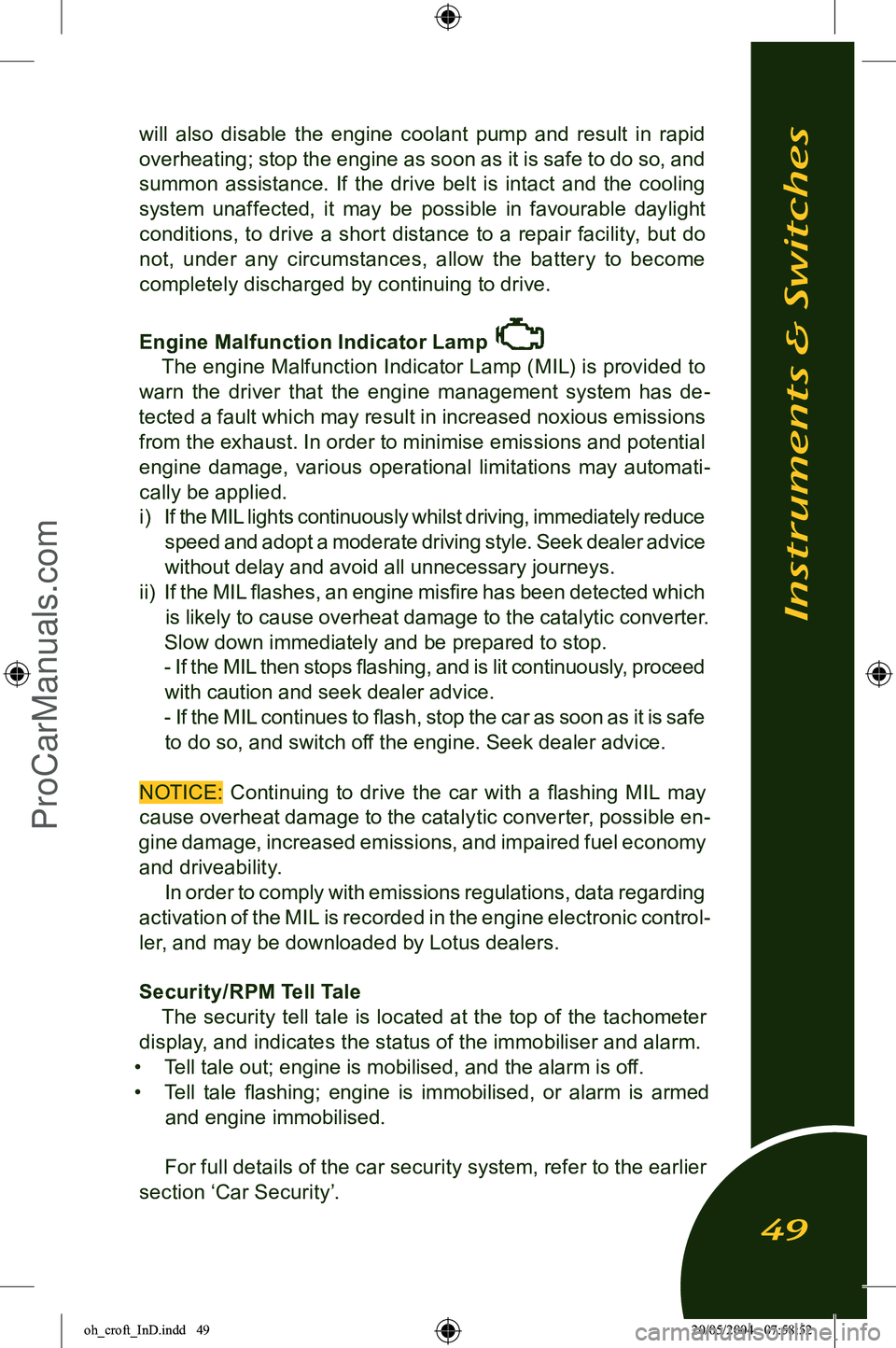
will also disable the engine coolant pump and result in rapid overheating; stop the engine as soon as it is safe to do so, and
summon assistance. If the drive belt is intact and the cooling
system unaffected, it may be possible in favourable daylight conditions, to drive a short distance to a repair facility, but do not, under any circumstances, allow the battery to become
completely discharged by continuing to drive.
Engine Malfunction Indicator Lamp
The engine Malfunction Indicator Lamp (MIL) is provided to
warn the driver that the engine management system has de
-
tected a fault which may result in increased noxious emissions from the exhaust. In order to minimise emissions and potential
engine damage, various operational limitations may automati
-
cally be applied. i) If the MIL lights continuously whilst driving, immediately reduce
speed and adopt a moderate driving style. Seek dealer advice
without delay and avoid all unnecessary journeys.
ii) If the MIL flashes, an engine misfire has been detected which is likely to cause overheat damage to the catalytic converter.
Slow down immediately and be prepared to stop.
- If the MIL then stops flashing, and is lit continuously, proceed with caution and seek dealer advice.
- If the MIL continues to flash, stop the car as soon as it is safe to do so, and switch off the engine. Seek dealer advice.
NOTICE:
Continuing to drive the car with a flashing MIL may
cause overheat damage to the catalytic converter, possible en
-
gine damage, increased emissions, and impaired fuel economy and driveability.
In order to comply with emissions regulations, data regarding
activation of the MIL is recorded in the engine electronic control
-
ler, and may be downloaded by Lotus dealers.
Security/RPM Tell Tale The security tell tale is located at the top of the tachometer
display, and indicates the status of the immobiliser and alarm.
• Tell tale out; engine is mobilised, and the alarm is off.
• Tell tale flashing; engine is immobilised, or alarm is armed
and engine immobilised.
For full details of the car security system, refer to the earlier
section ‘Car Security’.
Instruments & Switches
49
oh_croft_InD.indd 4920/05/2004 07:58:52ProCarManuals.com
Page 52 of 205
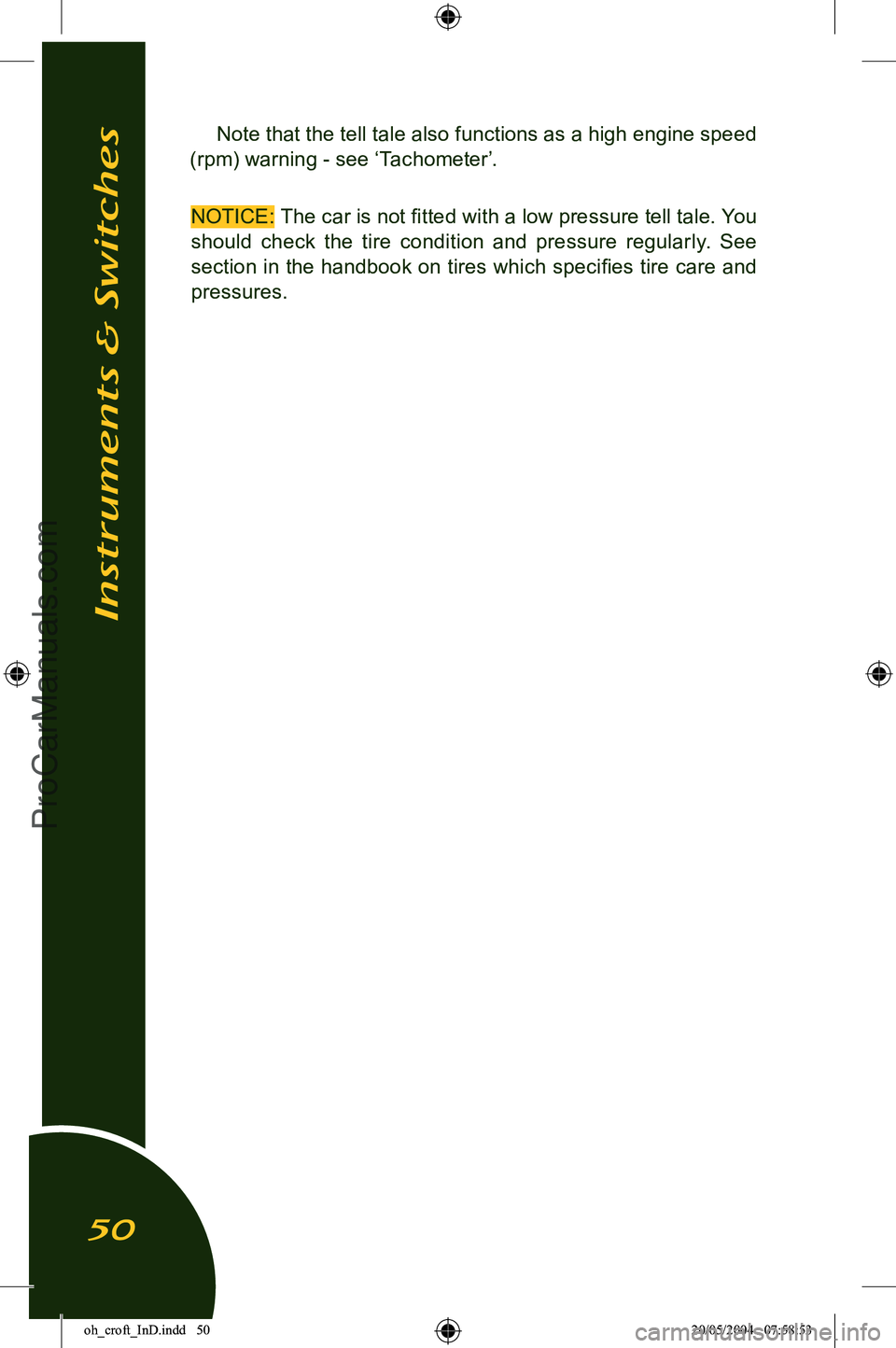
Note that the tell tale also functions as a high engine speed
(rpm) warning - see ‘Tachometer’.
NOTICE: The car is not fitted with a low pressure tell tale. You should check the tire condition and pressure regularly. See
section in the handbook on tires which specifies tire care and pressures.
Instruments & Switches
50
oh_croft_InD.indd 5020/05/2004 07:58:53ProCarManuals.com
Page 53 of 205
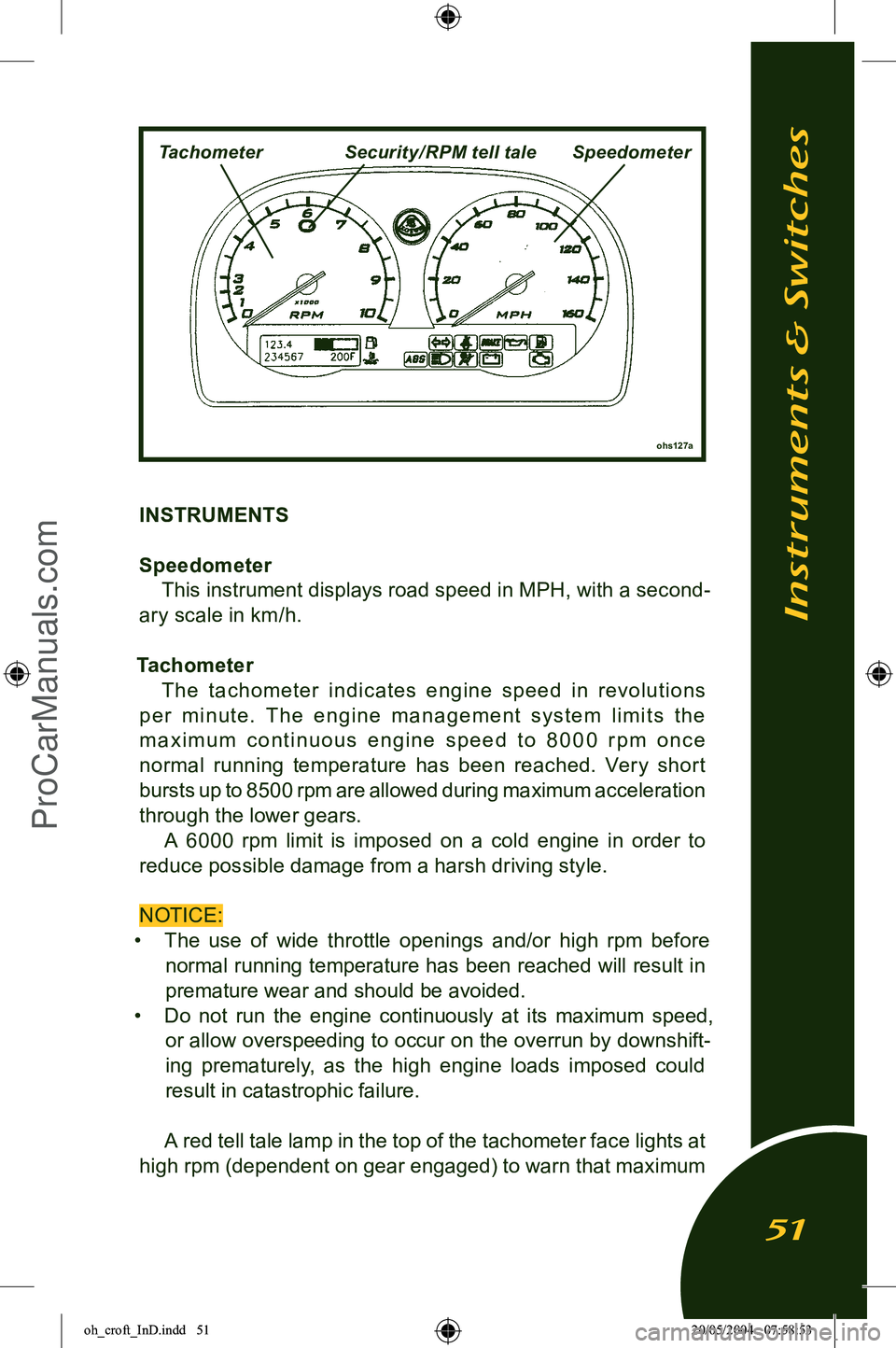
INSTRUMENTS
Speedometer This instrument displays road speed in MPH, with a second
-
ary scale in km/h.
Tachometer The t achometer indic ates engine speed in revolutions
p e r m i nu te. T h e e n g i n e m a n a g e m e nt sy s te m li m i t s t h e
m a x i m u m c o n t i n u o u s e n g i n e s p e e d t o 8 0 0 0 r p m o n c e
normal running temperature has been reached. Ver y shor t bursts up to 8500 rpm are allowed during maximum acceleration
through the lower gears. A 6000 rpm limit is imposed on a cold engine in order to
reduce possible damage from a harsh driving style.
NOTICE:
• The use of wide throttle openings and/or high rpm before
normal running temperature has been reached will result in
premature wear and should be avoided.
• Do not run the engine continuously at its maximum speed,
or allow overspeeding to occur on the overrun by downshift
-
ing prematurely, as the high engine loads imposed could
result in catastrophic failure.
A red tell tale lamp in the top of the tachometer face lights at
high rpm (dependent on gear engaged) to warn that maximum
Instruments & Switches
51
ohs127a
TachometerSecurity/ RPM tell taleSpeedometer
oh_croft_InD.indd 5120/05/2004 07:58:53ProCarManuals.com
Page 54 of 205
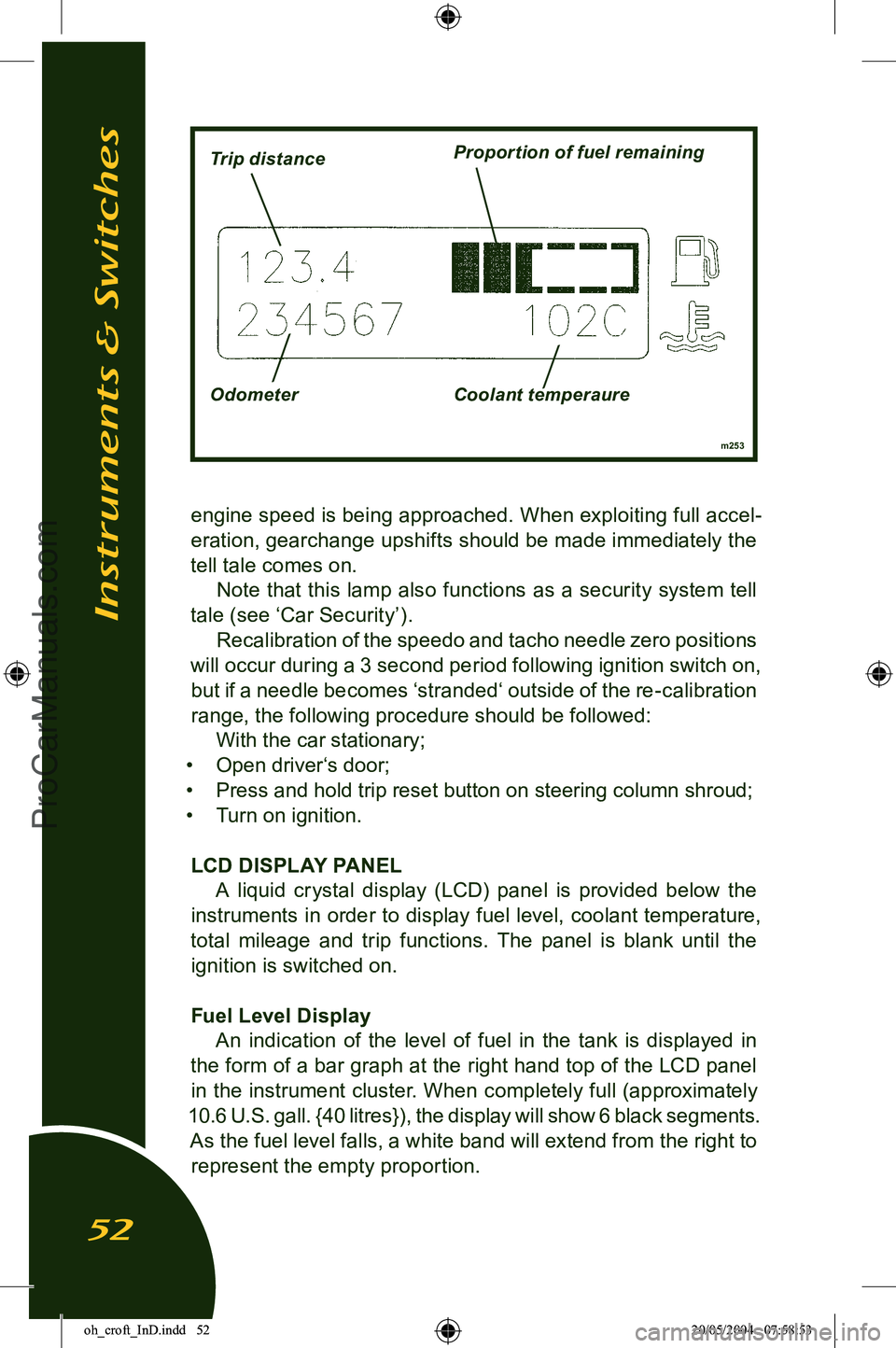
engine speed is being approached. When exploiting full accel-
eration, gearchange upshifts should be made immediately the
tell tale comes on.
Note that this lamp also functions as a security system tell
tale (see ‘Car Security’). Recalibration of the speedo and tacho needle zero positions
will occur during a 3 second period following ignition switch on,
but if a needle becomes ‘stranded‘ outside of the re-calibration
range, the following procedure should be followed:
With the car stationary;
• Open driver‘s door;
• Press and hold trip reset button on steering column shroud;
• Turn on ignition.
LCD DISPLAY PANEL A liquid crystal display (LCD) panel is provided below the
instruments in order to display fuel level, coolant temperature,
total mileage and trip functions. The panel is blank until the ignition is switched on.
Fuel Level Display An indication of the level of fuel in the tank is displayed in
the form of a bar graph at the right hand top of the LCD panel in the instrument cluster. When completely full (approximately
10.6 U.S. gall. {40 litres}), the display will show 6 black segments. As the fuel level falls, a white band will extend from the right to represent the empty proportion.
Instruments & Switches
52
m253
Trip distanceProportion of fuel remaining
Odometer Coolant temperaure
oh_croft_InD.indd 5220/05/2004 07:58:53ProCarManuals.com
Page 55 of 205
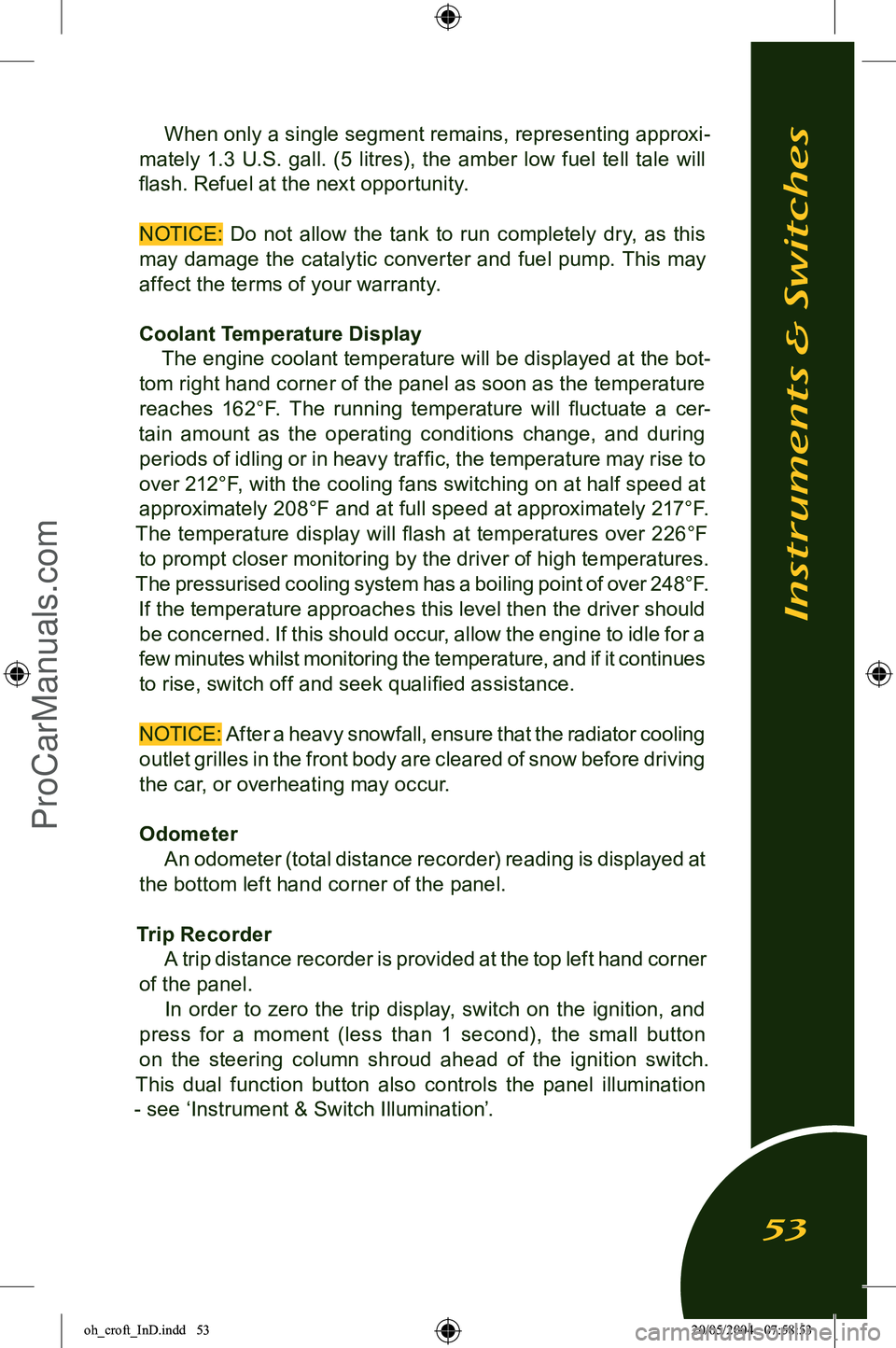
When only a single segment remains, representing approxi-
mately 1.3 U.S. gall. (5 litres), the amber low fuel tell tale will
flash. Refuel at the next opportunity.
NOTICE: Do not allow the tank to run completely dry, as this may damage the catalytic converter and fuel pump. This may
affect the terms of your warranty.
Coolant Temperature Display The engine coolant temperature will be displayed at the bot
-
tom right hand corner of the panel as soon as the temperature reaches 162°F. The running temperature will fluctuate a cer
-
tain amount as the operating conditions change, and during periods of idling or in heavy traffic, the temperature may rise to
over 212°F, with the cooling fans switching on at half speed at
approximately 208°F and at full speed at approximately 217°F.
The temperature display will flash at temperatures over 226°F to prompt closer monitoring by the driver of high temperatures.
The pressurised cooling system has a boiling point of over 248°F.
If the temperature approaches this level then the driver should be concerned. If this should occur, allow the engine to idle for a
few minutes whilst monitoring the temperature, and if it continues to rise, switch off and seek qualified assistance.
NOTICE: After a heavy snowfall, ensure that the radiator cooling
outlet grilles in the front body are cleared of snow before driving
the car, or overheating may occur.
Odometer An odometer (total distance recorder) reading is displayed at
the bottom left hand corner of the panel.
Trip Recorder A trip distance recorder is provided at the top left hand corner
of the panel. In order to zero the trip display, switch on the ignition, and
press for a moment (less than 1 second), the small button
on the steering column shroud ahead of the ignition switch.
This dual function button also controls the panel illumination
- see ‘Instrument & Switch Illumination’.
Instruments & Switches
53
oh_croft_InD.indd 5320/05/2004 07:58:53ProCarManuals.com
Page 56 of 205
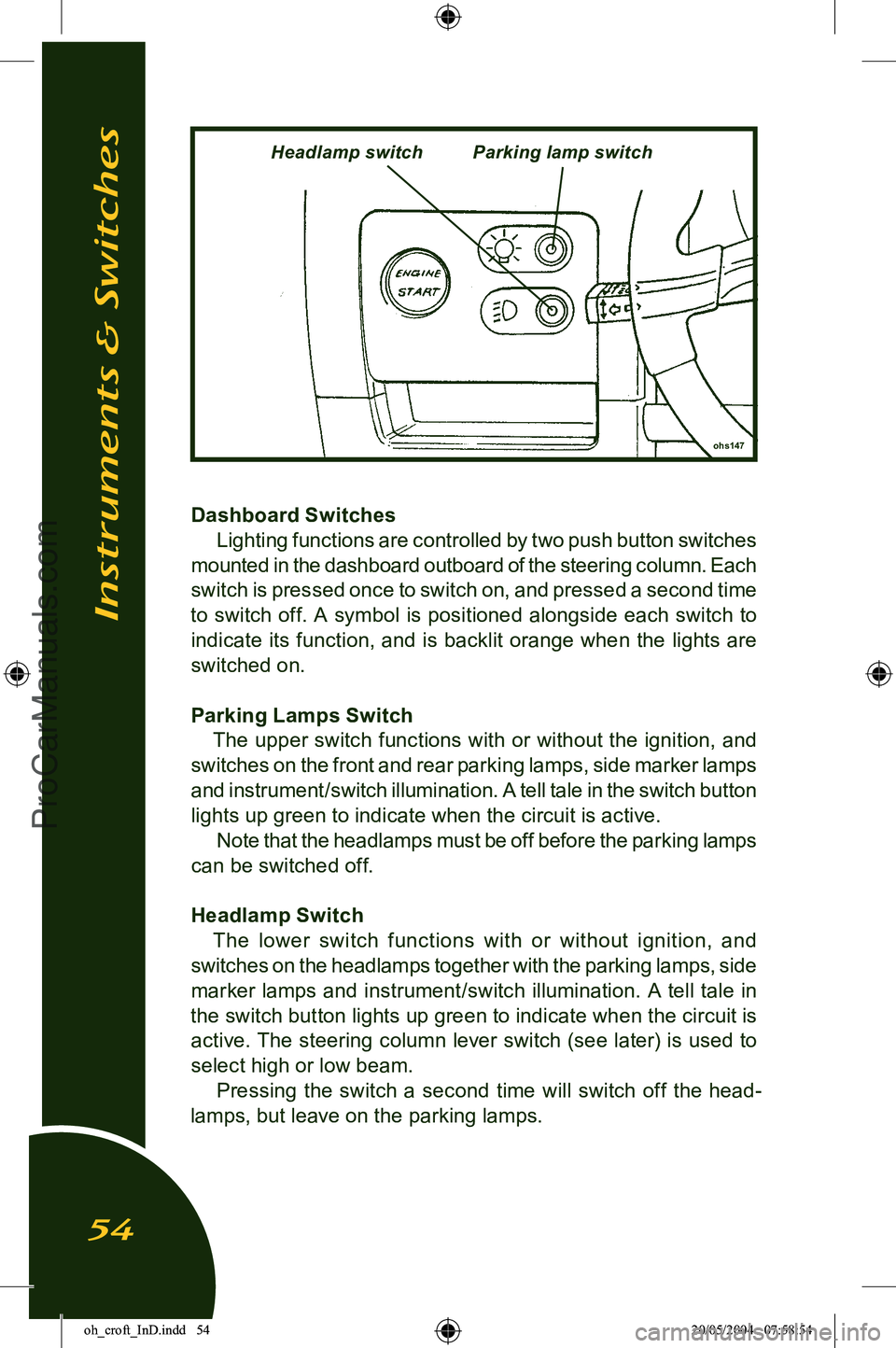
Dashboard SwitchesLighting functions are controlled by two push button switches
mounted in the dashboard outboard of the steering column. Each
switch is pressed once to switch on, and pressed a second time
to switch off. A symbol is positioned alongside each switch to indicate its function, and is backlit orange when the lights are
switched on.
Parking Lamps Switch The upper switch functions with or without the ignition, and
switches on the front and rear parking lamps, side marker lamps and instrument/switch illumination. A tell tale in the switch button
lights up green to indicate when the circuit is active. Note that the headlamps must be off before the parking lamps
can be switched off.
Headlamp Switch The lower switch functions with or without ignition, and
switches on the headlamps together with the parking lamps, side marker lamps and instrument/switch illumination. A tell tale in
the switch button lights up green to indicate when the circuit is
active. The steering column lever switch (see later) is used to
select high or low beam. Pressing the switch a second time will switch off the head
-
lamps, but leave on the parking lamps.
Instruments & Switches
54
ohs147
Headlamp switchParking lamp switch
oh_croft_InD.indd 5420/05/2004 07:58:54ProCarManuals.com
Page 57 of 205
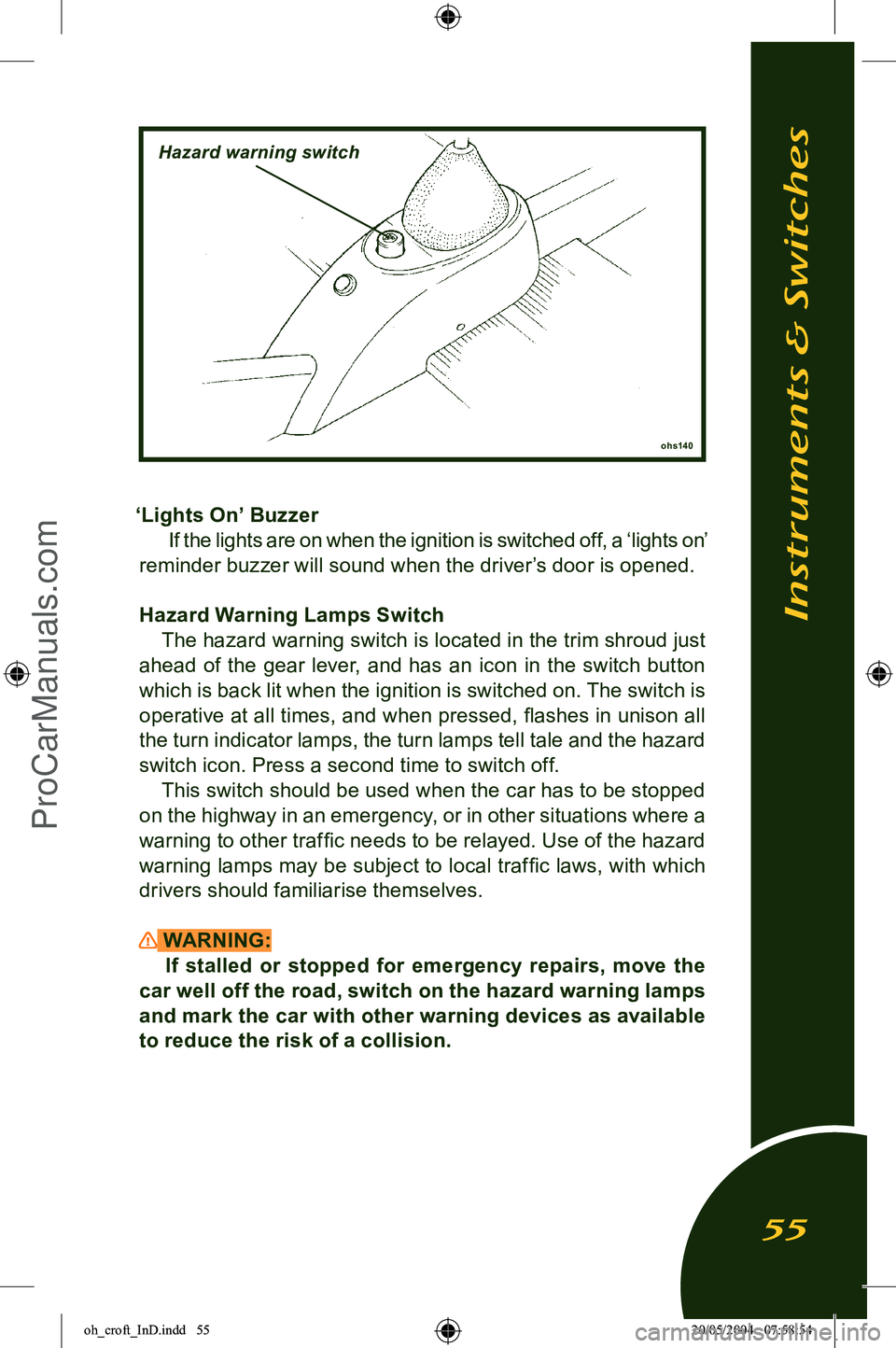
‘Lights On’ Buzzer If the lights are on when the ignition is switched off, a ‘lights on’
reminder buzzer will sound when the driver’s door is opened.
Hazard Warning Lamps Switch The hazard warning switch is located in the trim shroud just
ahead of the gear lever, and has an icon in the switch button
which is back lit when the ignition is switched on. The switch is operative at all times, and when pressed, flashes in unison all
the turn indicator lamps, the turn lamps tell tale and the hazard switch icon. Press a second time to switch off. This switch should be used when the car has to be stopped
on the highway in an emergency, or in other situations where a
warning to other traffic needs to be relayed. Use of the hazard
warning lamps may be subject to local traffic laws, with which drivers should familiarise themselves.
WARNING: If stalled or stopped for emergency repairs, move the
car well off the road, switch on the hazard warning lamps
and mark the car with other warning devices as available
to reduce the risk of a collision.
Instruments & Switches
55
ohs140
Hazard warning switch
oh_croft_InD.indd 5520/05/2004 07:58:54ProCarManuals.com
Page 58 of 205
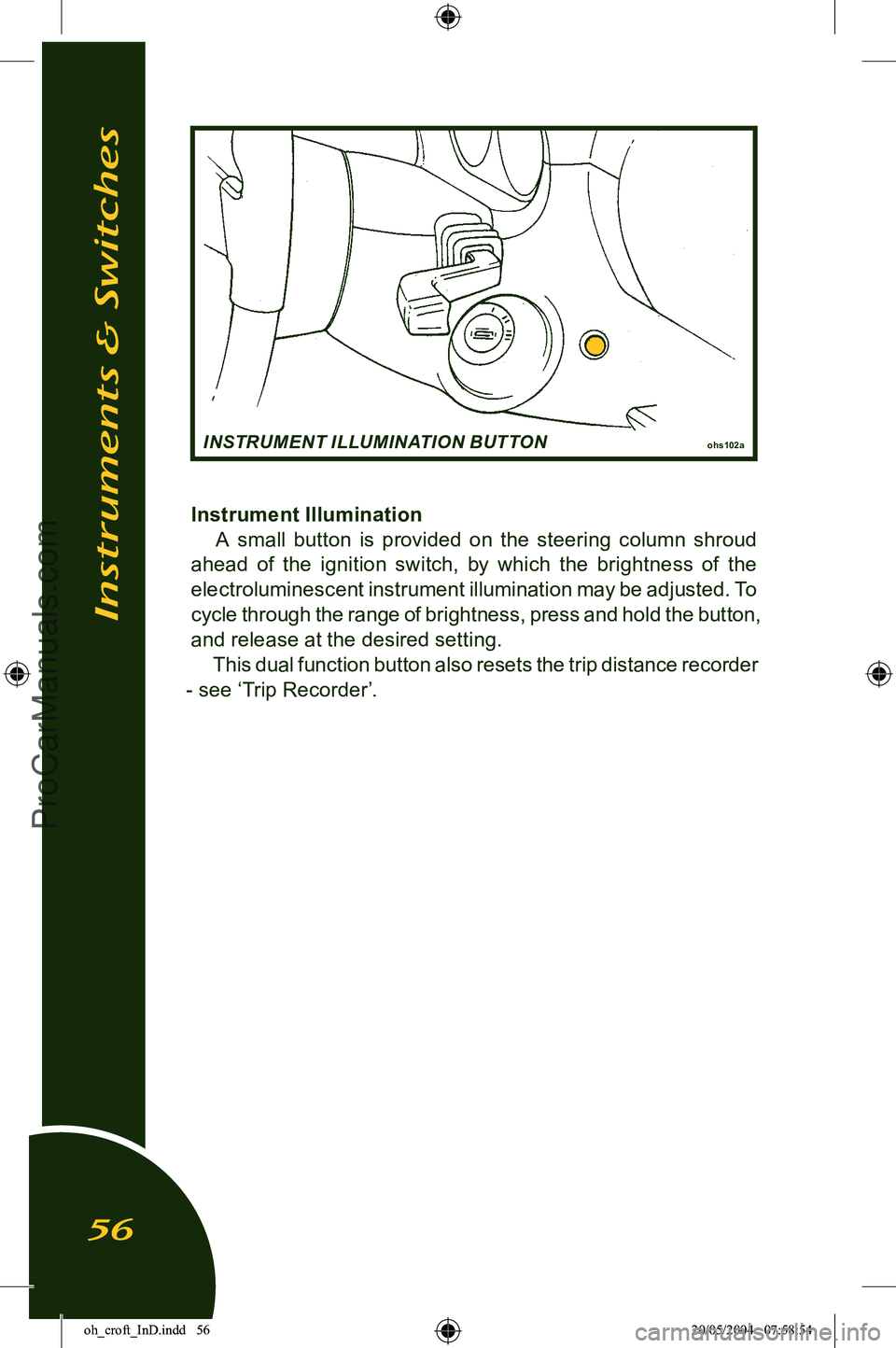
Instrument IlluminationA small button is provided on the steering column shroud
ahead of the ignition switch, by which the brightness of the
electroluminescent instrument illumination may be adjusted. To
cycle through the range of brightness, press and hold the button, and release at the desired setting. This dual function button also resets the trip distance recorder
- see ‘Trip Recorder’.
Instruments & Switches
56
ohs102aINSTRUMENT ILLUMINATION BUTTON
oh_croft_InD.indd 5620/05/2004 07:58:54ProCarManuals.com
Page 59 of 205
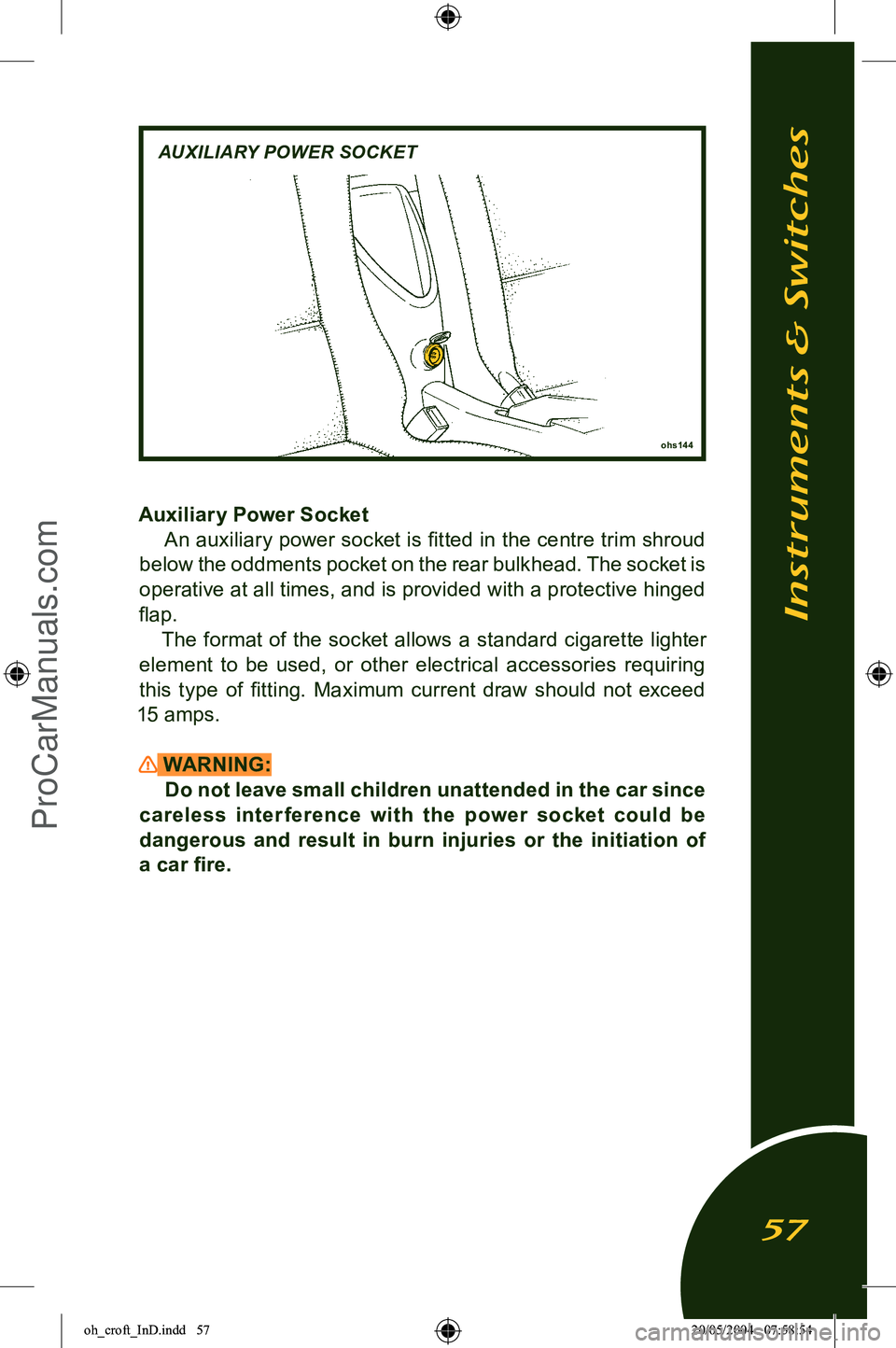
Auxiliary Power SocketAn auxiliary power socket is fitted in the centre trim shroud
below the oddments pocket on the rear bulkhead. The socket is
operative at all times, and is provided with a protective hinged
flap. The format of the socket allows a standard cigarette lighter
element to be used, or other electrical accessories requiring
this type of fitting. Maximum current draw should not exceed
15 amps.
WARNING: Do not leave small children unattended in the car since
careless inter ference with the power socket could be
dangerous and result in burn injuries or the initiation of a car fire.
Instruments & Switches
57
ohs144
AUXILIARY POWER SOCKET
oh_croft_InD.indd 5720/05/2004 07:58:54ProCarManuals.com
Page 60 of 205
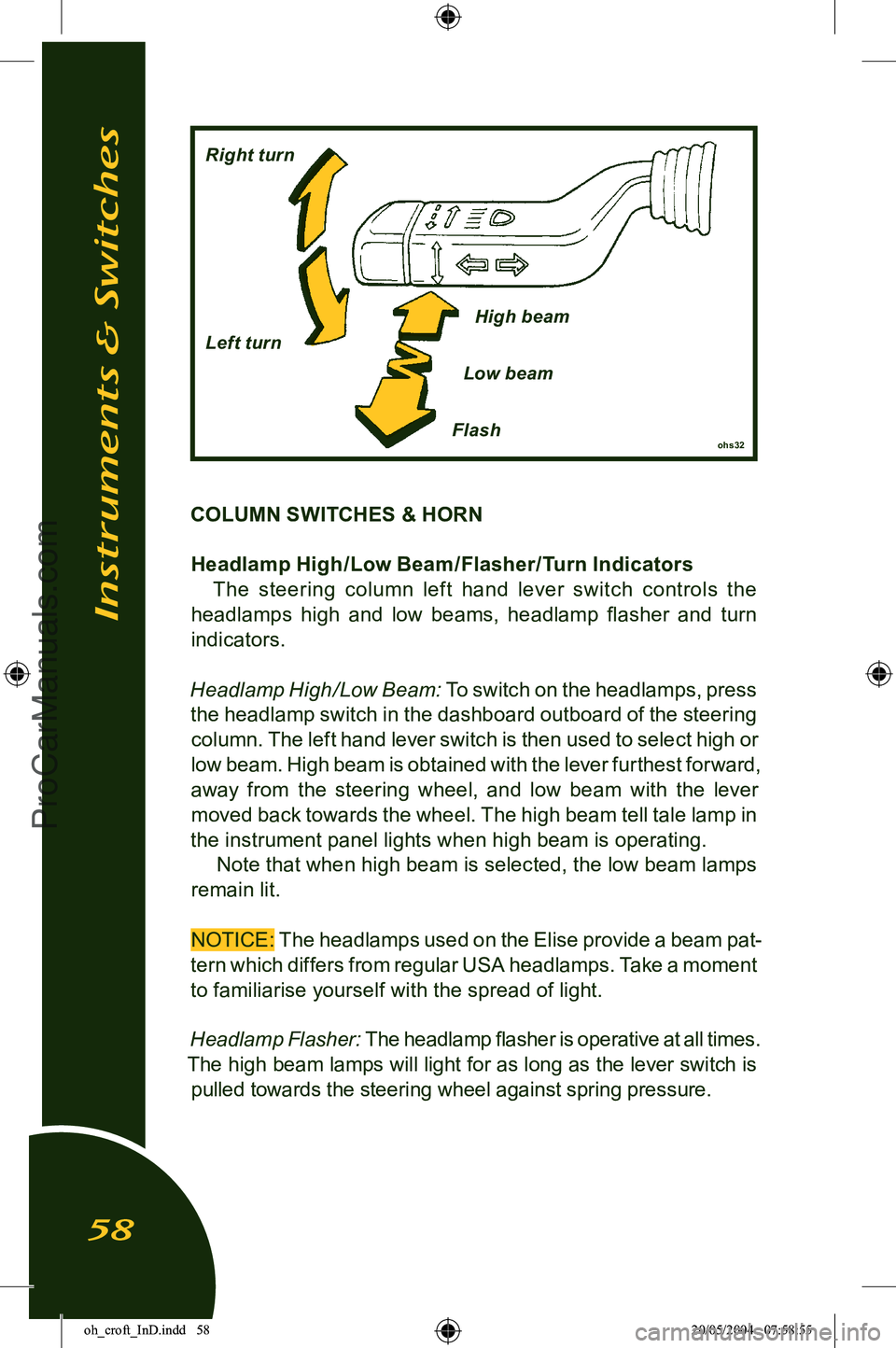
COLUMN SWITCHES & HORNHeadlamp High /Low Beam /Flasher/Turn Indicators The steering column lef t hand lever switch controls the
headlamps high and low beams, headlamp flasher and turn
indicators.
Headlamp High/Low Beam:
To switch on the headlamps, press
the headlamp switch in the dashboard outboard of the steering column. The left hand lever switch is then used to select high or
low beam. High beam is obtained with the lever furthest forward,
away from the steering wheel, and low beam with the lever moved back towards the wheel. The high beam tell tale lamp in
the instrument panel lights when high beam is operating.
Note that when high beam is selected, the low beam lamps
remain lit.
NOTICE:
The headlamps used on the Elise provide a beam pat-
tern which differs from regular USA headlamps. Take a moment
to familiarise yourself with the spread of light.
Headlamp Flasher:
The headlamp flasher is operative at all times.
The high beam lamps will light for as long as the lever switch is pulled towards the steering wheel against spring pressure.
Instruments & Switches
58
ohs32Flash
Right turn
Left turn
High beam
Low beam
oh_croft_InD.indd 5820/05/2004 07:58:55ProCarManuals.com